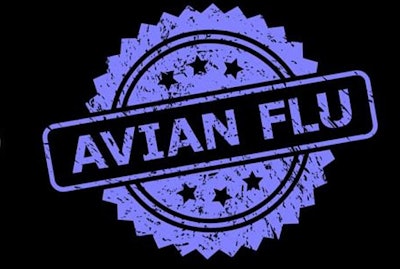
During the month of February, there were six outbreaks of highly pathogenic avian influenza (HPAI) linked to viruses of the H5 family in German domestic poultry flocks, one in captive birds at a zoo, and more cases among the wild bird population.
Together with other observed trends, these data support the continued national disease risk assessment at “high,” according to Germany’s veterinary reference laboratory, Friedrich-Loeffler Institute (FLI).
Of the six outbreaks in the nation’s poultry last month, FLI recorded two in laying hens, two in meat turkeys, and two in hobby chickens. Among the 63 cases in wild birds, 44 were found in the northern state of Schleswig-Holstein, and the rest in seven other states. Two of the cases tested positive for the H5N5 virus serotype, and the rest for the H5N1 variant.
FLI’s risk assessment also takes into account the six million poultry that have been lost to the disease across Europe since last autumn/fall. Furthermore, infections have been confirmed in a number of wild bird species. Particularly affected have been waterfowl near the North Sea and the Baltic Sea.
As a result, FLI considers that there is still a high risk of HPAI virus transmission from infected wild birds to the country’s poultry and captive birds.
Since the start of March, the FLI has recorded just two HPAI infections in avian species in Germany, both of which were in wild birds of prey.
Further HPAI cases in wild birds
As of March 8, 25 European states have registered one or more cases of HPAI in wild birds — a total of 325 outbreaks.
This is according to the latest edition of the Animal Disease Information System. Published by the European Commission (EC), it monitors the animal disease situation in European Union (EU) member states and adjacent countries.
Compared with the previous update dated March 1, this is an increase of 11 outbreaks, and Northern Ireland appears to have confirmed its first outbreak of 2024 in the first week of this month.
Totals for Denmark and Poland had each risen by three over the week, Sweden’s by two, and Romania’s and Slovenia’s each by one.
For the year to date, 104 outbreaks in wild birds have been reported in Germany, 62 in Denmark, 21 in Sweden, and 19 in Romania.
Additional information on outbreaks is given in official notifications from the national animal health agencies to the World Organisation for Animal Health (WOAH).
Among these registered over the past week are a total of four wild birds that have tested positive for the H5N1 HPAI virus serotype in three German states.
The great majority of HPAI cases among European wild birds since the start of the winter season have been linked to the H5N1 variant.
In the United Kingdom (U.K.), an HPAI infection has been confirmed in a bird of prey. Found dead in the East Lothian region in the southeast of Scotland, the bird tested positive for the H5N5 HPAI virus variant earlier this month.
2 outbreaks reported in European poultry flocks
Total outbreaks in the region’s commercial flocks stands at 131 for the year so far, according to the EC’s latest System update (dated March 8).
Up to that point, 15 countries in the region had reported one or more outbreaks in 2024. Romania registered its first cases in this category in the first week of March, increasing the EC’s regional total by one.
The highest total so far this year is from Moldova with 55, followed by Poland (24), and Germany (nine).
Meanwhile, the authority in Bulgaria has notified WOAH about one more HPAI outbreak on a commercial farm.
Starting on March 12, cases were observed among around 12,600 poultry at a premises in Pazardzhik. This was the first detection of the H5N1 HPAI virus in this southern province in 2024, and it brings the nation’s total outbreaks since the start of the year to nine. According to the notification, presence of the H5N1 virus serotype was confirmed, and the flock was depopulated.
In a separate category of “captive birds,” the EC System records HPAI outbreaks in non-commercial poultry, zoos, and similar premises.
As of March 8, the total for the category stands at 45. With a total of 22, the Czech Republic has registered the most outbreaks of this type since the start of 2024, followed by Germany (eight), and Ukraine (seven). The situation is unchanged from that published seven days earlier.
Norway reports another case in wild fox
To WOAH the Norwegian animal health agency has confirmed another HPAI infection in a second wild animal.
In the last week of February, a red fox tested positive for an H5 virus in the Troms and Finnmark region. It appears to have been found around one kilometer away from and five days after the previous case, also a red fox. Both animals were euthanized.
There is no clear evidence of direct mammal-to-mammal transmission of avian influenza viruses, according to a recent report published by the European Food Safety Authority (EFSA). The authors state that this is despite a growing number of reported cases, particularly in wild carnivores.
While the reasons for this increase are not fully understood, EFSA states that contact between infected wild birds and carnivores likely occurs frequently. As a result, it recommends close surveillance of the viruses in circulation, so that any strains showing signs of enhanced transmission to mammals are identified as soon as possible.
View our continuing coverage of the global avian influenza situation.

















